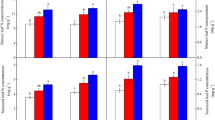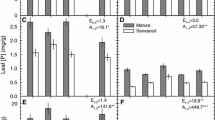Abstract
In the northern stretches of the Chihuahuan Desert, the margins of ephemeral stream channels called arroyos support a unique vegetation dominated by a guild of winter-deciduous shrubs. To explore the dynamics of nutrient conservation in this assemblage of arroyo shrubs, we measured nitrogen (N) and phosphorus (P) resorption efficiency and proficiency in six species of shrubs growing in arroyos in southern New Mexico. Collectively, these six species were no more efficient or proficient at resorbing N and P from senescing leaves than shrubs growing in other environments. Resorption efficiency averaged 53% and 50% for N and P, respectively, and resorption proficiency averaged 0.80% and 0.06% for N and P, respectively. However, resorption varied significantly between species specifically restricted in their distribution to riparian habitats (obligate riparian species), and those that were not. The two obligate riparian species combined (Brickellia laciniata, Chilopsis linearis) were significantly more efficient and proficient at resorbing N than the non-obligate riparian species combined (Fallugia paradoxa, Flourensia cernua, Prosopis glandulosa, Rhus microphylla). Additionally, both Brickellia and Chilopsis were individually significantly more proficient at resorbing N than any of the other four species. The dichotomy in resorption between obligate riparian species and those that were not may have been the result of the interplay between hydrology, geomorphology, and biology. Because arroyos move in space as the movement of water erodes banks and changes channel location, some plants are found along arroyos only because the arroyos have moved to them. These plants (plants growing by default) may be less well adapted to arroyo margins than obligate riparian species (plants growing by design). Significant differences in resorption between obligate and non-obligate riparian species suggested that evolutionary history and habitat specificity may be added to the list of factors known to influence resorption. Selected life history traits of the six species did not appear to be related to any measure of resorption, but leaf surface area, specific leaf mass, and nutrient concentrations in green leaves were all correlated with resorption efficiency or proficiency in one or more species. The only species capable of symbiotic N fixation, Prosopis glandulosa, retained at least 2.3 times more N in its senesced leaves than any other species. Patterns of resorption in arroyo shrubs strongly indicated that efficiency and proficiency are fundamentally different, complementary measures of resorption.
Similar content being viewed by others
Author information
Authors and Affiliations
Additional information
Electronic Publication
Rights and permissions
About this article
Cite this article
Killingbeck, K., Whitford, W. Nutrient resorption in shrubs growing by design, and by default in Chihuahuan Desert arroyos. Oecologia 128, 351–359 (2001). https://doi.org/10.1007/s004420100668
Received:
Accepted:
Published:
Issue Date:
DOI: https://doi.org/10.1007/s004420100668




